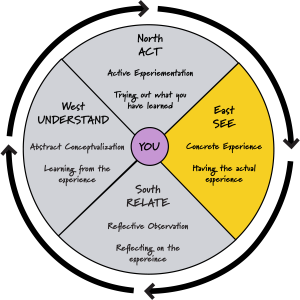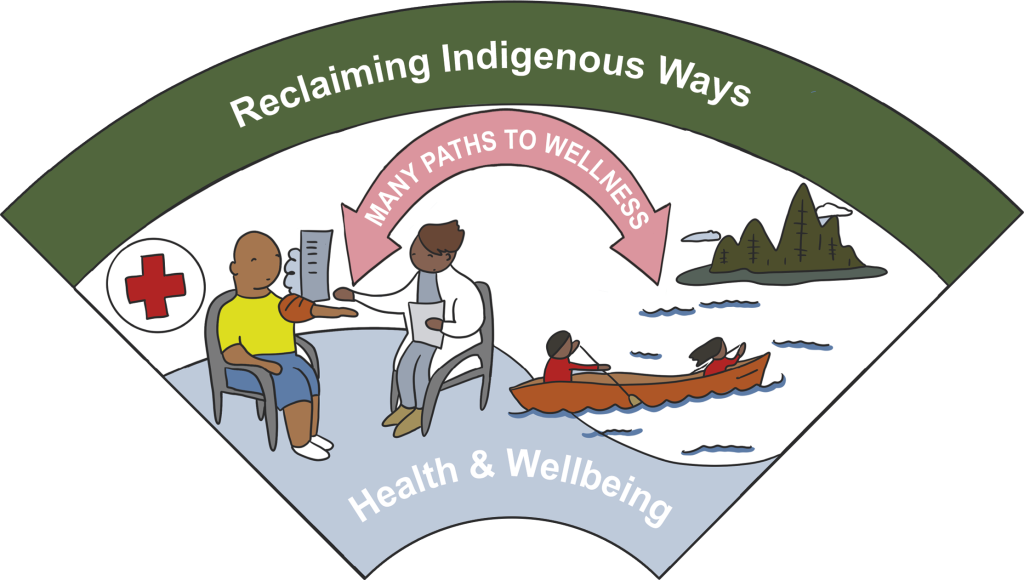
In Connection 1, you will learn that promoting wellness and providing culturally competent care involves practicing cultural humility.
THE EAST: SEEING WITH CONNECTION EXPERIENCES
You will begin Connection 1 in the East, where you will see an initial experience by watching the film This Was Real and engaging in a reflection checkpoint exercise.

Connecting Our Learning to the First Nations Mental Wellness Continuum Framework
In Module 1, Connection 6 we learned that wellness is connected to culture, language, and traditions. Culture permeates the entire First Nations Wellness Continuum Framework as the foundation for everything else. For Anishinaabeg and First Nations communities, culture is vitally important for wellness:
“Culture is an important social determinant of health, and a holistic concept of health is an integral part of a strong cultural identity. Many First Nations communities believe that the way to achieve individual, family, and community wellness (a balance of mental, physical, emotional, and spiritual aspects of life) is through culturally specific, holistic interventions. A positive and balanced state of well-being cannot be achieved unless individuals, families, and communities are supported to openly express their own unique cultural identity … When culture is considered the foundation, all First Nations health services can be delivered in a culturally relevant and [culturally] safe way” (Thunderbird Foundation, 2022, p.33).
You will continue your learning about culture and health care how this impacts the lives of Anishinaabeg in the case of cancer. Watch the following video keeping in mind how culture is important to Anishinaabeg when encountering the health care system, in this case of cancer.
THIS WAS REAL
In this film [19:57] Anishinaabe women’s experiences with cancer are presented through an interpretive journey. The film depicts one woman’s struggle with life choices and the weight of emotional burdens in coming to terms with what was once an unknown disease in her culture.
Video Transcript: This Was Real Documentary [Doc]
Key Messages from the Video
- Having an illness like cancer is scary but it should not have power over you
- Anishinaabe people deal with illnesses like cancer in ways that are rooted in language, cultural beliefs, and their understandings of health and wellness
- The process for figuring out a cancer illness is rigorous and can be confusing
- Having “no choice” is problematic and can diminish a person’s power and strength
- While the process of living with cancer might look similar for non-Indigenous peoples, Indigenous peoples rely on culture and traditional ways of healing that call for cultural humility and safety in their service providers
Connecting the Film to Nbisiing Nishnaabeg Wellness
In Module 1, Connection 8 we learned about wellness from the Nbisiing Nishnaabeg perspective. Recall that Reclaiming Nbisiing Nishnaabeg Ways was Theme 5.

“For Nbisiing Debendaagziwaad living a good life [mino-bimaadiziwin] is an integrated experience where the spirit connects to Creation. That connection promotes the values one carries, and the formation of positive identities. This sense of connectedness is supported and is made explicit by reclaiming Nbisiing Nishnaabeg ways to wellness” (Peltier et al., 2022).
Checkpoint 1: Reflection Response
Reflect on your own humility in learning about Anishinaabe culture and views of wellness.
Think about the Seven Grandfather’s teaching of Bekaadziwin (Humility) “to know yourself as a sacred part of creation. You are equal to others, but you are not better.”
How has the film and the teaching of Bekaadziwin (Humility) made you think differently about your own understanding of health and wellness?
Answer by either recording yourself speaking or by taking notes. Be sure to download a copy of your audio clip or notes before proceeding on.
Connection 1 Summary
In Connection 1, we learned:
- Wellness is constructed or understood through our experiences and for the Anishinaabeg, it is rooted in language and cultural beliefs which are continually being reclaimed
- Anishinaabeg have many paths to wellness which can be fostered with service providers who understand that there are many ways to heal
- Mino-bimaadiziwin (the good life) encompasses more than western bio-medical healing methods

To move on to Connection 2, click on the “Next: Connection 2: Reflecting on Your Positionality and Understanding of Wellness →” button at the bottom right hand corner of this page.
References
Peltier, C. (Writer), & Lucas, S.D. (Director). (2020, November). This Was Real. [Film]. Vimeo. https://vimeo.com/453846089![]()
Peltier, C., Manankil-Rankin, L., McCullough, K., & McLeod-Shabogesic, L. (2022). Wellness and wiidooktaadyang: Moving Anishinaabe knowledge into action [Manuscript submitted for publication]. Faculty of Education and Professional Studies, Nipissing University.
Thunderbird Partnership Foundation. (2022). First Nations mental wellness continuum framework. https://thunderbirdpf.org/fnmwc/![]()

